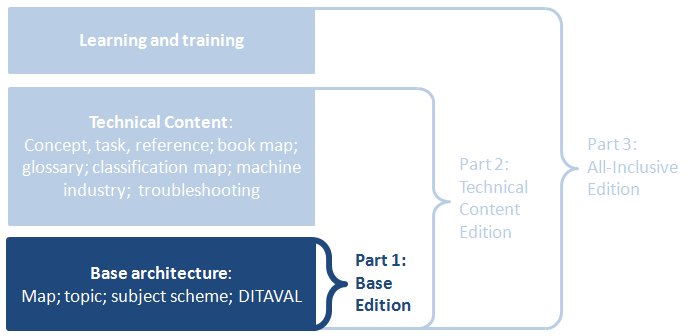Specification URIs
This version
Previous version
Not applicable.
Latest version
Technical Committee
Chair
Kristen James Eberlein (kris@eberleinconsulting.com), Eberlein Consulting LLC
Editors
- Kristen James Eberlein (kris@eberleinconsulting.com), Eberlein Consulting LLC
- Nancy Harrison (nharrison@infobridge-solutions.com), Individual member
- John Hunt (john_hunt@us.ibm.com), IBM
- Amber Swope (amber@ditastrategies.com), Individual member
Additional artifacts
This document is part of a work product that also includes:
- ZIP file that contains the DITA source for this document. http://docs.oasis-open.org/dita/dita-1.3-why-three-editions/v1.0/cn01/dita-1.3-why-three-editions-v1.0-cn01-dita.zip
Abstract
DITA 1.3 is distributed in three editions to better serve the needs of specific user communities. The specific user communities are those that are interested in:
- Core DITA
- Technical content
- Learning, training, and instructional design
This committee note explains the rationale for the three editions; it also provides an overview of what each edition contains, the intended audience of each edition, and metrics about each edition.
Status
This document was last revised or approved by the OASIS Darwin Information Typing Architecture (DITA) TC on the above date. The level of approval is also listed above. Check the “Latest version” location noted above for possible later revisions of this document.
TC members should send comments on this document to the TC’s email list. Others should send comments to the TC’s public comment list, after subscribing to it by following the instructions at the “Send A Comment” button on the TC’s web page at https://www.oasis-open.org/committees/comments/index.php?wg_abbrev=dita.
Citation format
When referencing this note, the following citation format should be used:
- [DITA-why-three-editions]
- DITA 1.3: Why Three Editions? Version 1.0. Edited by Kristen James Eberlein, Nancy Harrison, John Hunt, and Amber Swope. 17 November 2015. Committee Note 01. http://docs.oasis-open.org/dita/dita-1.3-why-three-editions/v1.0/cn01/dita-1.3-why-three-editions-v1.0-cn01.html. Latest version: http://docs.oasis-open.org/dita/dita-1.3-why-three-editions/v1.0/dita-1.3-why-three-editions-v1.0.html.




